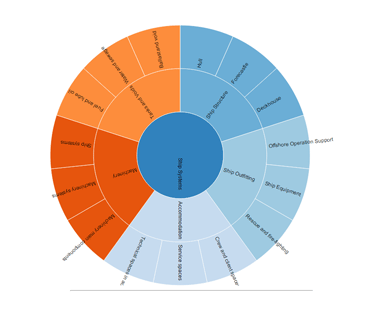Parametric Ship Design
A Simple Application in HTML + Javascript
by Henrique M. Gaspar - Associate Professor Aalesund University College / Ulstein International SA
(hega @ hials.no), v0.1, Dec 2013.


Introduction to Parametric Design
Parametric Design Example
1 - Mission, Requirements and Capabilities
The problem is to design an AHTS for the support of offshore operations. The purpose of the design is narrowed to supply, anchor handling and towing missions. More industrial related purposes of OSV design are discussed by Ulstein and Brett [5,6]. Each mission is considered a set of operational profiles, with minimal requirements related to the task activity, such as: supply capacity (e.g. cargo volume >= 5000m3 and cargo area >= 500m2 ), field operations requirements (e.g. bollard pull (e.g. >= 200ton), illustrated in Figure 2.

Figure 2 - AHTS link between stakeholder's expectatations and mission performance
An OSV mission is decomposed in three operational profiles: anchor handling, supplging and towing. Each of the operational states’ requirements are connected to three vessel capabilities: cargo deck area [m2], bollard pull [MT] and cargo volume [m3].
Table 1 - Mission, requirements and capabilities
| Capability | A. Handling | Supplying | Towing | Total |
|---|---|---|---|---|
| Cargo deck area [m2] | ||||
| Bollard pull [MT] | ||||
| Cargo volume [m3] |
The value of the table connects mission requirements with vessel capabilities.By changing any of the values, the total required capability changes, modifying the criteria and the requirement dependency wheel below.
2 - Linking capabilities requirements to vessel parameters via parametric equations
The next step consists of linking the capabilities with the vessel parameters, via the design equations, obtaining a minimum value for the capabilities installed. These values are used later as one of the criteria to evaluate the design.
A set of concepts and assumptions is then defined, for the mapping between the design variables and design behavior. This process includes the knowledge intrinsic to the design process. In this example, only for illustrative purposes, our assumptions will be based under a regression analysis from similar designs. A total value for the requirements is found in Table 2.
- Cargo volume: (∝) 0.4 * the cubic number (CN) [m3]
- Cargo deck Area: (∝) 0.4 * Total Deck Area [m2]
- Powering: (∝) Bollard Pull [ton]
Table 2 - Linking mission requirements with equivalent vessel capability
| Max. Capability Requirements | Total Value Re. | Equivalent Capacity Required |
|---|---|---|
| Cargo deck area [m2] | LB [m2] | |
| Bollard pull [MT] | Powering [kW] | |
| Cargo volume [m3] | LBD [m3] |
The total value required for each capability from Table 1 is connected an equivalent vessel capability. This connection is based on the parametric study and other design information."
3 - Defining Main Vessel Parameters
The definition of the main vessel parameters is also obtained from the parametric equations. In this example, the hull is defined based on these equations, having the value of length (L) and block coefficient (CB) as user defined. The breadth/length (B/L), depth/breadth (D/B) and draft/depth (T/D) ratios are flexible within the range obtained at the parametric study. For the sake of illustration, an amount of extra powering and price per gross tonnage (kNOK/GT) can also be defined by the designer.
Table 3 - Vessel parameters
| Parameters | Value | Range |
|---|---|---|
| Length [m] | ||
| Breadth/Length | ||
| Breadth [m] | ||
| Depth/Breadth | ||
| Depth [m] | ||
| Draft/Depth | ||
| DraftDesign [m] | ||
| CB | ||
| Powering [kW] | ||
| Price / GT [kNOK/GT] |
By sliding the bars and modifying the vessel parameters we are able to change its capabilities, and consequently evaluate if the criteria is met.
4 - Criteria
The last step consists of checking the parameters with the criteria defined by the mission, evaluting the design.
Table 4 - Criteria Evaluation
| Capabilities | Value | Criteria Met (y/n) |
|---|---|---|
| LBD [m3] | ||
| LB [m2] | ||
| Power [kW] |
The criteria is calculated based on the mission requirements. A "Yes" means that the vessel parameters complies with the requirements."
5 - Output - Design Description
A final design description is obtained at the end of the iterative process.
Table 5 - Design Description
| Main Characteristics | Value |
|---|---|
| Length [m] | |
| Breadth [m] | |
| Depth [m] | |
| Draft [m] | |
| GT | |
| Cb | |
| Displacement [ton] | |
| Attributes | |
| Cargo Volume [m3] | |
| Cargo Area [m2] | |
| Installed Power [kW] | |
| Price [kNOK] |
This table summarizes the vessel characteristics and attributes, based on the parameters.
References
- Parsons, M. G., Parametric Design, Chapter 11 in Ship Design and Construction vol. 1, SNAME 2004
- Erikstad, S. O. and Levander, K., System Based Design of Offshore Support Vessels, in IMDC – Galsgow, UK, 2012
- Gaspar, H.M. et al. Handling Temporal Complexity in the Design of Non-Transport Ships Using Epoch-Era Analysis. Transactions RINA, Vol 154, Part A3, International Journal Maritime Engineering, Jul-Sep 2012
- Gaspar, H.M. et al., Addressing Complexity Aspects in Conceptual Ship Design - A Systems Engineering Approach. Transactions of SNAME, Vol. 120, 2013
- Ulstein, T., and Brett, P. O. Seeing what is next in design solutions: Developing the capability to build a disruptive commercial growth engine in marine design. International Maritime Design Conference - Trondheim (2009).
- Ulstein, T., and Brett, P. O. Critical systems thinking in ship design ap- proaches. International Maritime Design Conference - Glasgow (2012).

